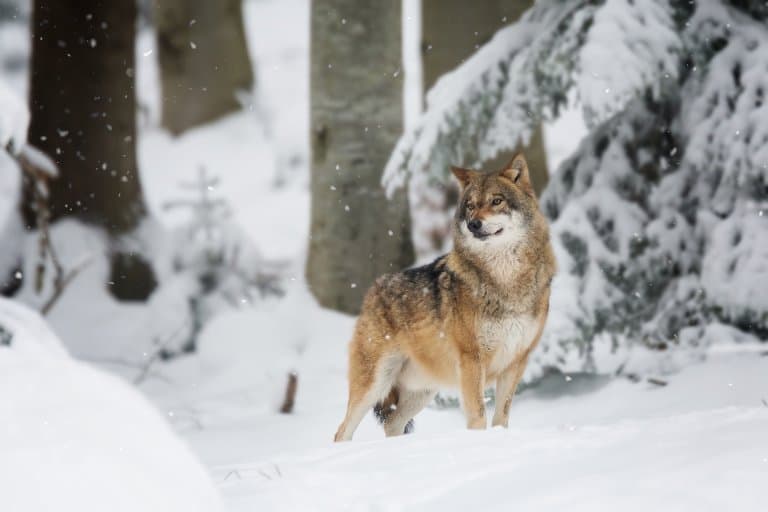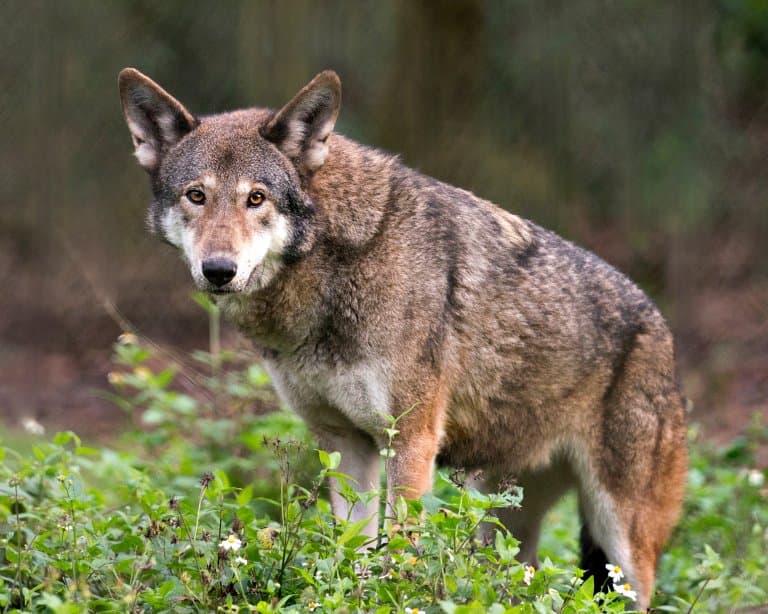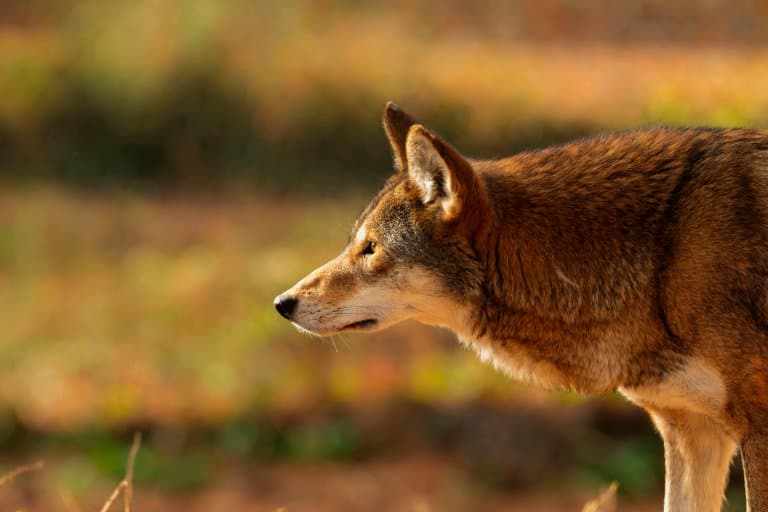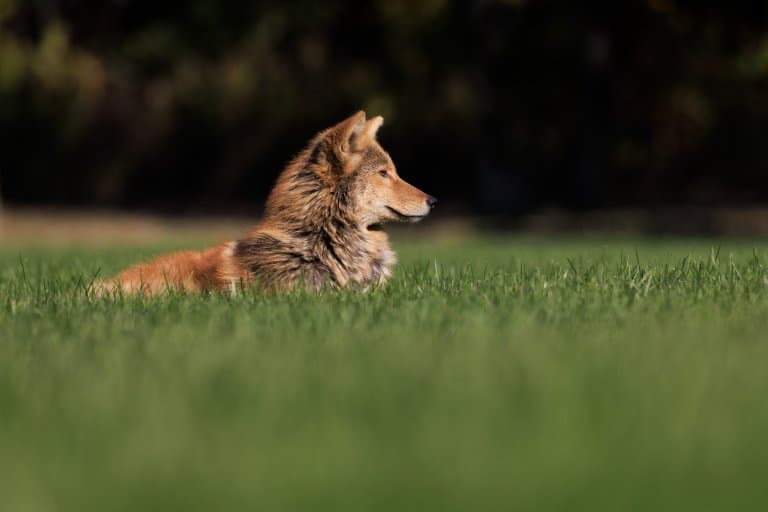Red Wolf Profile
Red wolves are an attractive member of the wolf family native to southeastern United States. These canids are smaller than their close cousin, the grey wolf and considerably larger than a coyote. Once considered to be a subspecies of the grey wolf, they are now accepted as a separate species.
The red wolf is a lean, relatively long-limbed wolf, with a tawny coat, a black-flecked back and a generally thinner coat than the grey wolf. They closely resemble the domestic dog, sometimes compared to the German shepherd breed with their relatively large ears and broad muzzle.
Although they historically inhabited a variety of different habitats, red wolves are most commonly found in mountainous forests and swamp areas. However where human disturbance is low, they can also thrive in prairie and wetland habitats.

Red Wolf Facts Overview
| Habitat: | Mountains and swamp areas |
| Location: | Eastern North Carolina |
| Lifespan: | Around 7 years in the wild |
| Size: | 1.3m in length, including the tail. Height around 70cm |
| Weight: | Up to 40kg |
| Colour/Appearance: | Slim, slender-bodied wolf with broad muzzle and brown to reddish coat. White patches around the mouth and eyes and back flecked with black |
| Diet: | Carnivorous, mainly feeding on small mammals |
| Predators: | Grey wolves, coyotes and possibly alligators |
| Top Speed: | Up to 50km/h |
| Number of Species: | 1 |
| Threats: | Habitat loss, habitat fragmentation, hunting and hybridisation with coyotes |
| Conservation status: | Critically endangered |
They are incredibly shy wolves and tend to avoid any areas where people frequent and thus are very rarely seen in the wild. Their shy and stealthy nature makes red wolves superb predators, able to move large distances without being seen or heard. Along with the grey wolf and black bear, the red wolf is considered a top predator in its habitat.
Hunting in small packs or alone, red wolves are mostly active during the night but will hunt at any time of the day when undisturbed. These skilled hunters may travel over 30km in a single day in search of prey, which mainly consists of small mammals, such as rabbits, and raccoons.
They are generalist in their prey choice and will eat prey as small as insects, as large as deer and will also readily feed on carrion. Red wolves catch prey in a variety of ways; they may chase prey to exhaustion, catch animals through quick chases or even ambush unsuspecting prey from concealed viewing spots.
Compared to the coyote, the red wolf is a far more social canid, living in small packs of around 6 individuals, usually consisting of a breeding pair and their pups. These family groups are highly territorial and will attack other wolves who venture into their territory.=
Once prevalent throughout several states across southeastern United States, the red wolf population now comprises of only around 16 individuals living in the wild (as of April, 2023). In the past the red wolf was ruthlessly hunted as part of predator control programs and this coincided with huge losses of habitat within their range.
As recently as 1980 the red wolf was declared extinct in the wild, but thanks to conservation breeding programmes, they are now found in the wild in the Alligator River National Wildlife Refuge in North Carolina and are being breed in captivity for planned reintroduction into other protected areas.
Interesting Red Wolf Facts
1. The red wolf is closely related to the coyote and the grey wolf
Red wolves share many similarities with grey wolves and coyotes. 1

2. They can breed with coyotes
Hybridisation with coyotes is one of the biggest threats red wolves face.
3. Some scientists believe red wolves are a subspecies of the grey wolf
Grey wolves and coyotes can produce fertile offspring and some scientists believe this gave rise to the red wolf. 2
4. They feed on animal matter, but may eat fruits when hungry
Red wolves are skilled predators and can catch animals as large as deer but they will also feed on carrion, as well as berries when prey is in short supply.
5. Packs will chase off other wolves from their territory
Even though they are smaller, red wolves will readily attack grey wolves if they stray into their territory. 3 4

6. They help control the spread of invasive rodents
Nutria or coypu are highly destructive, invasive rodents and red wolves help control their populations. 5
7. Red wolves live in very close-knit packs
They communicate with one another through scent marking, body language and vocalisations, which all pack members are able to interpret.
Pack members will help care for injured members as well as working in teams to catch larger prey, such as white-tailed deer.
Red wolf pups are raised by the whole pack until they reach around 1 year old and then they leave to create their own territory.
8. Males and females are monogamous
Breeding pairs will remain together their entire lives. In the wild, red wolves breed only once a year, producing an average of 5 pups in a litter.
Dens are well hidden and are usually made in depressions in the ground either under tree roots, along river banks and sometimes in fallen, hollow trees.
9. They learn to hunt from a young age
Young red wolves are taught to hunt once they are old enough to leave the den. Play is crucial in developing the physical skills needed to catch prey and when still relatively young, red wolves spend much of their time playing just outside their den.
Once they begin exploring with the pack, they learn how to track and catch prey and how to work together to tackle larger target animals.
When chasing white-tailed deer for example, red wolves will attempt to confuse the deer by attacking from various points, before tiring the animal and then working as a group to pull the animal down.
10. They actually help livestock farmers
Red wolves will chase any coyotes from their home range and this benefits farmers as coyotes can become nuisance killers of livestock.

11. The population of red wolves has increased as a result of conservation efforts
Although there are likely fewer than 20 wild red wolves, more than 200 live in special red wolf breeding centres. 6
12. Some of the wild red wolves are collared to help keep track of them
Information from radio collars help us better understand red wolves. The collars also reflect light, making it easier for drivers to avoid any wolves on roads.
13. Red wolves help increase the numbers of birds in their habitat
By feeding on rodents, who kill bird chicks and eat bird eggs, red wolves help bird species such as quail flourish.
14. Red wolves are possibly the most endangered canid in the world
Yet, as with many carnivores, they play a crucial role in maintaining a balanced ecosystem.
As excellent hunters, they are able to control the populations of rodents and rabbits that would otherwise have an extremely detrimental effect on the ecosystem. Once considered to be a ruthless killer of livestock, it has now been established that they have a negligible impact on livestock and this in turn aids in red wolf conservation efforts.
If reintroduction plans are successful the red wolf may once again inhabit large areas of its historical range. 7
Red Wolf Fact-File Summary
Scientific Classification
| Kingdom: | Animalia |
| Phylum: | Chordata |
| Class: | Mammalia |
| Order: | Carnivora |
| Family: | Canidae |
| Genus: | Canis |
| Species: | Canis Rufus |
Fact Sources & References
- “Red Wolf”, U.S. Fish & Wildlife Service.
- “Red wolves”, National Geographic.
- “NATURAL HISTORY-Red Wolf”, Center for Biological Diversity.
- “Red Wolf”, The National Wildlife Federation.
- “Red Wolves in North Carolina”, North Carolina Wildlife federation.
- Joseph W. Hinton (2013), “Red Wolf (Canis rufus) Recovery: A Review with Suggestions for Future Research”, NIH.
- Lauren K. Toivonen (2022), “An Initial Habitat Suitability Analysis for the Red Wolf Across its Historical Range”, Meridian Allenpress.
